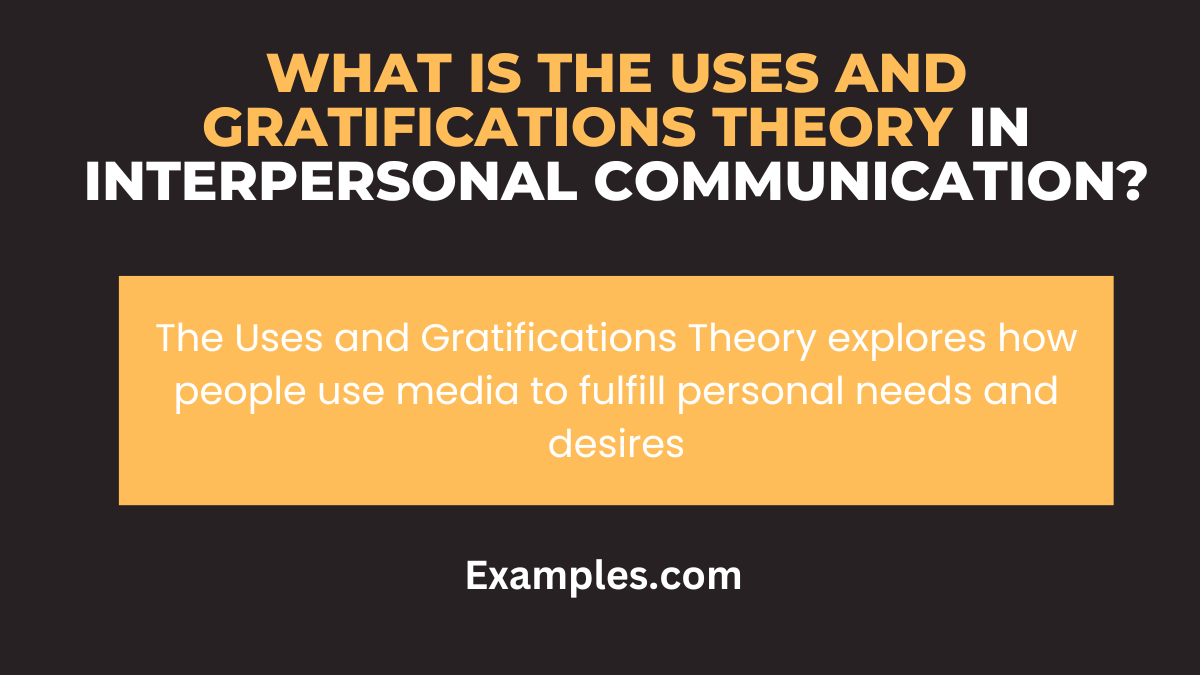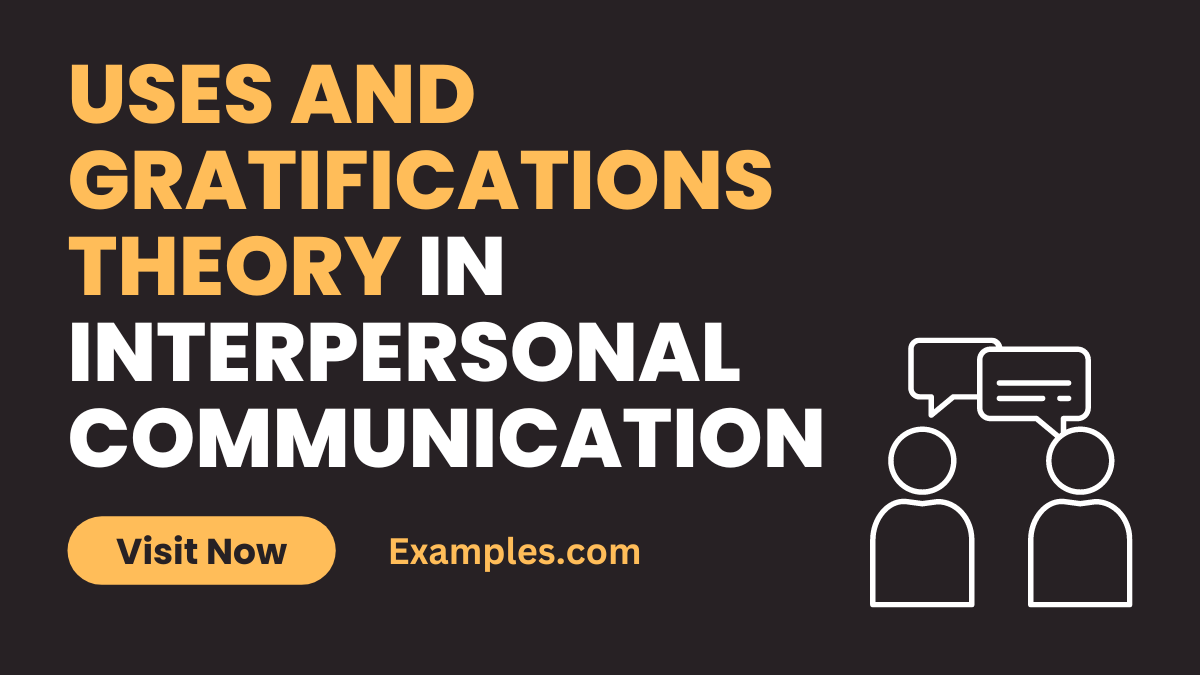Uses and Gratifications Theory in Interpersonal Communication
Understanding the Uses and Gratifications Theory in Interpersonal Communication offers valuable insights into why individuals engage in specific communicative behaviors. This theory, a cornerstone in communication studies, delves into the motivations and outcomes of interpersonal interactions. It emphasizes the active role of individuals in seeking out communication channels and content that fulfill their diverse needs, be it for information, personal identity, integration, or entertainment. This guide provides a comprehensive exploration of how this theory applies to various forms of communication, enriching one’s understanding of human interactions.
What is the Uses and Gratifications Theory in Interpersonal Communication?

The Uses and Gratifications Theory in Interpersonal Communication is a psychological communication perspective that investigates why people select specific communication channels and content, and what they gain from these choices. Unlike other theories that focus on the sender’s message and its impact, this theory emphasizes the receiver’s active role in selecting and interpreting communication based on their needs, desires, and gratifications sought.
History
Who Created: Elihu Katz, Jay G. Blumler, and Michael Gurevitch
Date: 1940s
The Uses and Gratifications Theory in Interpersonal Communication originated in the 1940s, evolving through the decades. It fundamentally explores how individuals actively seek out media to satisfy various personal needs. Their research emphasized the audience’s active role in interpreting and integrating media, marking a shift from traditional, passive perceptions of media consumption. This theory is integral to understanding the dynamic nature of Digital Communication and Public Communication in contemporary society.
What is the Best Example of Uses and Gratifications Theory in Interpersonal Communication?
A prime example of the Uses and Gratifications Theory in action within interpersonal communication is social media usage. People use platforms like Facebook or Instagram not only for staying connected with friends and family but also for self-expression, seeking information, and entertainment. For instance, someone might engage in online discussions to feel a sense of belonging to a community or to validate their personal opinions and identity. This example illustrates how different interpersonal communication channels are used to satisfy diverse personal needs and gratifications.
20 Examples of Uses and Gratifications Theory in Interpersonal Communication

The Uses and Gratifications Theory in interpersonal communication explores how individuals actively seek out specific media to satisfy diverse needs. This concept, crucial in Interpersonal Communication Examples and Theories of Interpersonal Communication, emphasizes the proactive role of individuals in communication processes, differing in their motivations and the gratifications they derive.
1. Sharing Personal Achievements:
Example: “I just got promoted at work!”
This statement fulfills the need for self-esteem and personal growth, showcasing verbal affirmation in Interpersonal Communication.
2. Expressing Emotions:
Example: “I feel really happy today!”
Demonstrates emotional expression, a key aspect of non-verbal and verbal communication.
3. Seeking Advice:
Example: “What do you think I should do about this situation?”
This is a practical use of interpersonal communication for problem-solving and support.
4. Offering Comfort:
Example: “I’m here for you, no matter what.”
Shows emotional support and empathy, vital in interpersonal relationships.
5. Sharing News and Information:
Example: “Did you hear about the new policy update?”
This is an example of using interpersonal communication for informational purposes.
6. Networking for Professional Purposes:
Example: “Let’s connect on LinkedIn to discuss business opportunities.”
Illustrates the use of digital and verbal communication in professional networking.
7. Engaging in Small Talk:
Example: “Nice weather we’re having today, isn’t it?”
Small talk is a fundamental aspect of initiating and maintaining interpersonal relationships.
8. Resolving Conflicts:
Example: “Let’s talk and find a solution together.”
Highlights the use of verbal and non-verbal cues in managing interpersonal conflicts.
9. Building Rapport in Interviews:
Example: “Tell me more about your experiences in this field.”
Uses verbal communication to establish connections in professional settings.
10. Expressing Sympathy:
Example: “I’m sorry for your loss; I’m here if you need anything.”
Shows the role of emotional expression in providing comfort and sympathy.
11. Sharing Artistic Interests:
Example: “Have you seen the latest art exhibition?”
Incorporates elements of visual and verbal communication in sharing interests.
12. Discussing Health Concerns:
Example: “I’ve been feeling unwell; what do you think it could be?”
Demonstrates the importance of verbal communication in expressing personal health concerns.
13. Planning Events or Meetings:
Example: “Let’s set a date for our next team meeting.”
This is an application of organizational communication in a small group setting.
14. Giving Instructions or Directions:
Example: “Turn left at the next corner to reach the café.”
Shows the use of clear and concise verbal communication in providing directions.
15. Expressing Gratitude:
Example: “Thank you so much for your help today!”
An important interpersonal communication tool for expressing appreciation.
16. Discussing Educational Topics:
Example: “What did you think of today’s lecture?”
Utilizes verbal communication in an educational context.
17. Sharing Travel Experiences:
Example: “Let me tell you about my trip to Paris!”
Involves storytelling and descriptive language in interpersonal communication.
18. Discussing Movies or TV Shows:
Example: “Have you watched the latest episode of that series?”
A common topic in everyday verbal interactions.
19. Engaging in Political Discussions:
Example: “What’s your view on the recent election results?”
Illustrates the use of interpersonal communication in discussing societal issues.
20. Exchanging Cultural Insights:
Example: “In my culture, we celebrate this festival in a unique way.”
Shows the role of interpersonal communication in sharing and learning about different cultures.
What are the Elements of Uses and Gratifications Theory in Interpersonal Communication?
- Audience Activity: Involves active audience participation in selecting media to fulfill personal needs.
- Media Use Motivation: Identifying reasons why individuals choose specific media channels.
- Gratification Sought and Obtained: Distinguishes between the gratifications sought by the audience and those obtained from the media.
- Personal and Social Circumstances: The context in which media is used, influenced by personal and social factors.
- Perceived Availability of Alternatives: Considering other media sources available to fulfill the same needs.
- Media Content Preferences: Preferences in media content that align with personal interests and values.
- Cognitive, Affective, and Social Utilitarianism: The use of media for cognitive needs (information), affective needs (emotional), and social needs (connectivity).
- Behavioral Outcomes: The effect of media use on an individual’s behavior and attitudes in Interpersonal Communication.
What are the Needs in Uses and Gratifications Theory in Interpersonal Communication?
- Cognitive Needs: Seeking information, knowledge, and understanding through media.
- Affective Needs: Using media for emotional, pleasurable experiences.
- Personal Integrative Needs: Media as a means of strengthening credibility, confidence, stability, and status.
- Social Integrative Needs: Media for connecting with family, friends, and society.
- Escape Needs: Using media to escape from problems or routine life.
- Identity Formation Needs: Finding media that helps in personal identity formation or affirmation.
- Information Seeking Needs: Utilizing media to stay updated and informed.
- Entertainment Needs: Engaging with media for amusement and leisure purposes.
What are the Advantages of Uses and Gratifications Theory in Interpersonal Communication?
| Advantage | Description |
|---|---|
| Understanding Audience Behavior | Helps in comprehending why individuals choose certain media to fulfill specific needs. |
| Insights into Media Effects | Provides understanding of how different media can satisfy various personal and social needs. |
| Enhancing Media Literacy | Encourages critical thinking about the choices and uses of media. |
| Facilitating Targeted Communication | Assists in designing communication strategies that align with audience preferences. |
| Personal Empowerment | Empowers individuals to select media that best suits their needs. |
| Cultural and Social Awareness | Encourages exploration of diverse media, leading to broader cultural and social understanding. |
| Adaptation to Technological Changes | Reflects changing preferences in the wake of new media technologies. |
| Promoting Interpersonal Relationships | Aids in understanding the role of media in shaping and reflecting Interpersonal Relationships. |
Constructivist Theory in Interpersonal Communication is essential. By following the provided tips and guidelines, you can effectively convey this theory in your writing. Encourage readers to explore the dynamic nature of communication, emphasizing the co-construction of meaning and the role of context. Mastering this theory enriches interpersonal communication knowledge and fosters more meaningful and adaptable interactions.



